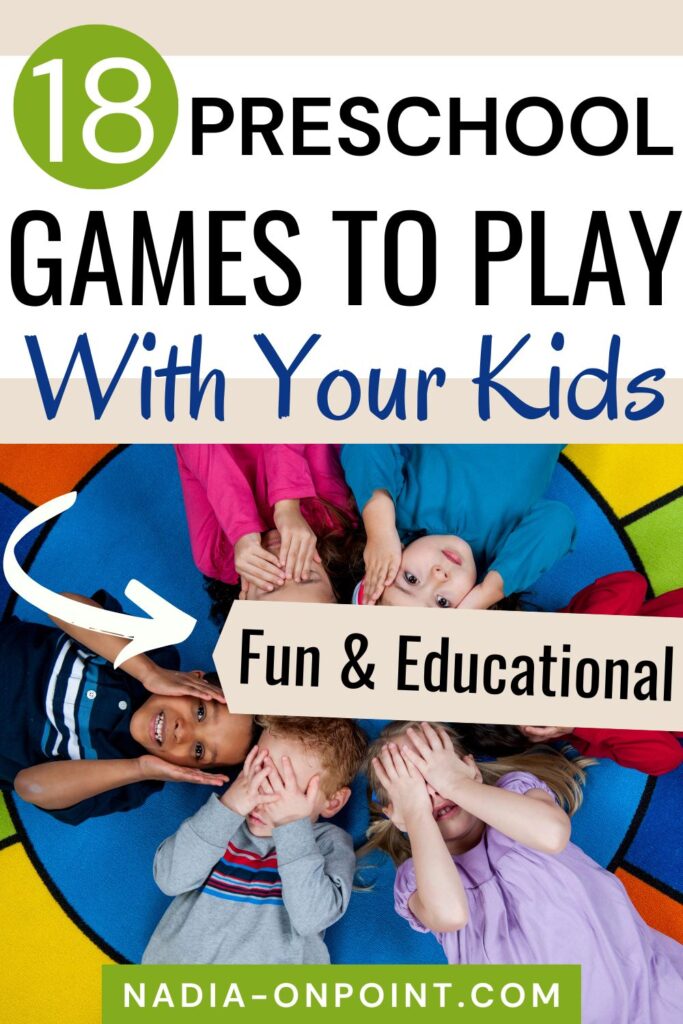As a parent, you play an essential role in your child’s education, even before they start school. One way to support your child’s development is by playing games.
“Play is how children learn,” says Dr. Tiff Jumaily, a pediatrician and a fellow of the American Academy of Pediatrics.
Play is natural for children and supports their cognitive, physical, social, and emotional well-being. Children can test their limits and create challenges. Parents can connect with their children through play and share in the happiness it brings them.

Preschool Games
Here are eighteen games you can play with your preschooler to help them develop and have fun.
1. I Spy
I Spy is a classic game that is a great way to build vocabulary and understand language. One person chooses an object in the room and gives clues about what it is (“I spy with my little eye something that starts with the letter B”). The child then guesses what the object is. You can add more items and pictures as you go.
2. Simon Says
Simon Says is a great game to play to help your child practice following instructions. To play, choose one player to be Simon and have them give instructions to the other players, such as “Simon says touch your nose” or “Simon says stand up.” The catch is that the players can only follow the instructions if Simon precedes them with the phrase “Simon says.” Players who do not hear “Simon says” before an instruction must not follow it. If a player does the action without Simon saying so, then they will be the only ones doing the silly action. You can add a process of elimination for older children whereby any child that does the action without “Simon says” has to sit down and wait out the rest of the game.
3. Red Light, Green Light
Squid Game may have disturbed us with its version of Red Light Green Light, yet this is still a great game to try with preschoolers (minus the massive bloodbath). One person is chosen as the stoplight and stands at one end of the room or yard. The other players line up on the other side. When the stoplight player turns around and says “green light!” the other players can move. When the stoplight says “red light,” the players must freeze. If players move when the stoplight is red, they must return to the start—the first person to reach the stoplight wins.
4. Musical Chairs
To play Musical Chairs, you will need one less chair than the number of kids playing. The chairs are placed in a circle facing outwards. The players walk around the chairs while music plays. When the music stops, everyone has to sit down quickly on a chair. The person who doesn’t find a seat is out and takes away one of the chairs. Continue until there is only one person left who is declared the winner.
5. Take an Online Class
Give yourself a break from parenting and get your child to take an online class! Educational platforms such as Allschool offer engaging live video classes for kids as young as three. Explore phonics, songs, stories, sight words, and more with a course designed just for preschoolers. Classes for this age group typically last for 25-30 minutes.
6. Hot Potato
Play Hot Potato with a small or a large group. Players sit in a circle and pass around an object like a potato, bean bag, or ball. They must pretend that the potato is hot. The person who is holding the potato when the music stops is out. The game continues until there is only one player left.
7. The Hokey Pokey
The Hokey Pokey is a great way to get your child moving and help them learn body parts. It also teaches the concepts of in and out, left and right. To play, “you put your right hand in, put your right hand out, put your right hand in, and you shake it all about!” You continue this with the left hand, right foot, left foot, and so on. If the children are learning a foreign language, translate the body parts with this versatile song.
8. Head Shoulders Knees and Toes
Similar to The Hokey Pokey, Head Shoulders Knees and Toes is excellent for helping your child learn the names of body parts. To play, you sing the song while touching the corresponding body part. As you sing faster, it becomes more challenging. This is very easy and fun to play.
9. Paint a Picture
Another option for your play date is painting with washable paint. This activity is suitable for at-home learning with some strict monitoring. Be sure to give them a lot of room to make a mess. Set up a large blank piece of paper and some paint pots in different colors, and let your child go to town!
10. Duck Duck Goose
Duck Duck Goose is an excellent strategic-thinking game played with a group of any size. If you remember this game from childhood, you choose one person to walk around the circle of children, tapping their heads as they go, saying “duck” for each child. They then choose one person in the circle as a “goose” to chase them around the circle. After a child has been called a “goose” they must stand up and catch the person before they do a full 360 degrees around the circle. If they miss the other player, that child then leads the next round, walking around the circle and saying, “duck… duck…”
11. Preschooler Apps
There are several apps available that can help your child learn while they play. According to a review published in the American Academy of Pediatrics, apps could be beneficial for teaching early math (number recognition, number naming, addition) and language (alphabet, letter sounds, vocabulary) skills in children under six. The apps are gamified to keep the child’s interest. A popular app for preschoolers is The Khan Academy for Kids.
12. What’s the time, Mr. Fox?
What’s the time, Mr. Fox? is great for practicing numbers and telling the time. One player is chosen to be Mr. Fox and stands about 20 feet away from the other children. The children ask, “What time is it, Mr. Fox?” the fox replies with a specific time, and they have to move forward that number of steps. For example, the children must move seven spaces forward if the fox says, “it is 7 o’clock.” If the fox says “dinner time!” the fox chases the players back to the start line and has to try and tag them. The tagged person then becomes Mr. Fox.
13. Hopscotch
To play Hopscotch, you’ll need to draw a hopscotch grid on the ground with chalk. To start, the player tosses a small stone or bean bag into a hopscotch square without touching the lines. They must complete the hopscotch course without hopping on the square with the stone. The children must plan ahead, all while hopping on one foot.
14. Race for a Ribbon
Add different colored ribbons to wooden spoon handles in Race for a Ribbon. Call out a color and have your little one dash to the spoons and choose the right one. If the preschoolers are older, you may want to tell them to go and find the color that is the same as their T-shirt or favorite book. Take turns giving each other the instructions.
15. Hide n’ Seek
Hide n’ Seek is a classic game played indoors or outdoors. One person is chosen as the seeker, and the other players hide. The seeker then has to find all the hidden players. Once all the players are found, the roles reverse, and the next person becomes the seeker. Switch it up and hide their stuffed animal or another favorite toy.
16. Chutes and Ladders
Chutes and Ladders is a classic board game played by two or more people. The object of the game is to reach the finish first by climbing ladders and avoiding chutes. This board game teaches counting, winning, losing, and taking turns.
17. Snap Cards
Playing snap is a simple card game for two or more players. The game’s object is to get rid of all your cards by matching them with the card on top of the pile. The players have to react quickly to spot the cards that match. Your preschooler may like many junior packs of snap cards with characters such as superheroes, princesses, and animals.
18. Coloring Sheets
Last but not least, we have coloring sheets! Coloring sheets are great because they provide your child with visual support while they learn their colors. You can find coloring sheets for any subject online or in most stores selling children’s educational materials. Once you have some coloring sheets printed, sit down with your child and color together! It’s a great way to bond while they learn something new.
In Conclusion
These are just a few of the many available preschool games. With so many options, you’re sure to find something that your child will enjoy. Not only are these games fun, but they also help to develop important skills such as problem-solving, critical thinking, and fine motor skills. So get out there and start playing! This article originally appeared on Wealth of Geeks.
More Ideas from this Category
About the author
Caitriona Marie
Caitriona is a private language tutor and founder ofTPR Teaching.Caitriona has been teaching the English language since 2016. She has taught in schools in Spain and the U.K., and she currently teaches online. On her blog, you will find tons of English language articles, worksheets, resources, tips, and advice for learners and teachers.








Reading this brings back a lot of childhood memories. Great post!
I’m always looking for things to play with my kiddos. Thank you for these ideas!